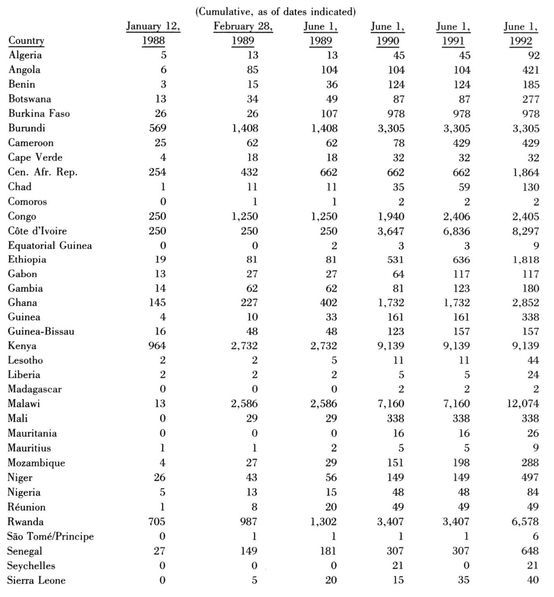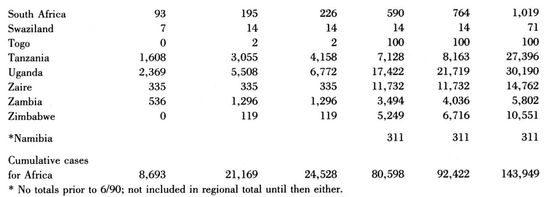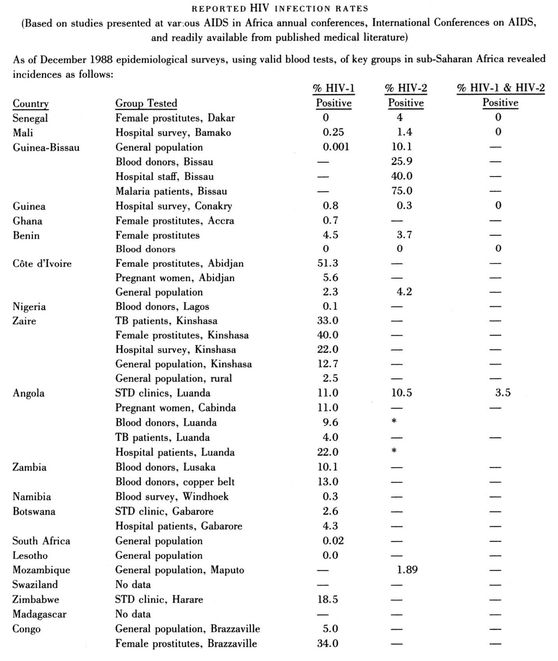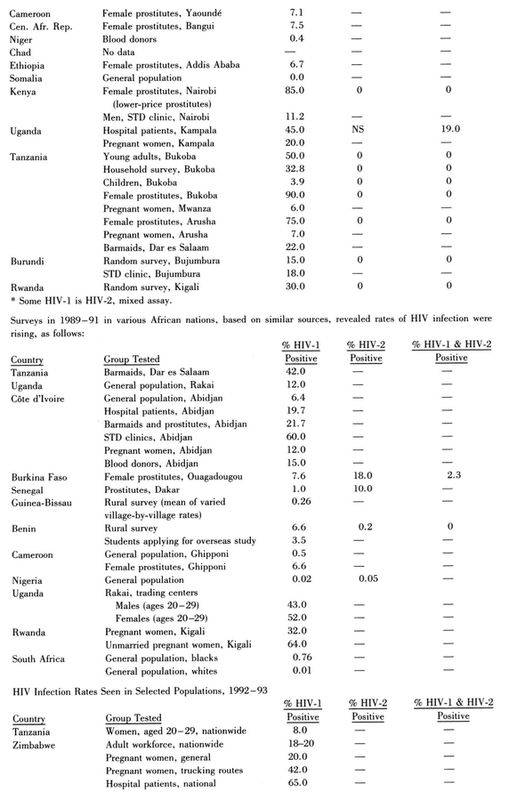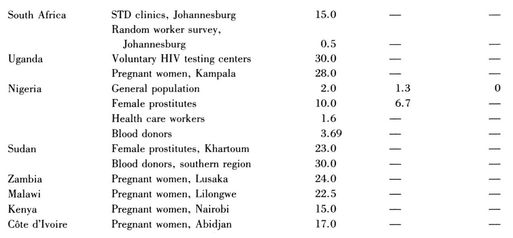The Coming Plague (135 page)
Authors: Laurie Garrett

20
Much has been written about behavioral and societal responses to AIDS, though few serious scientific studies of the matter have been funded. The National Academy of Sciences in the United States identified lack of information about human sexual and drug use behavior and responses to epidemics as the
key
factors responsible for failure to find ways to stop AIDS. Yet most governments remained loath to sponsor such studies, even thirteen years after the pandemic began, because of the religious, political, and cultural sensitivities involved in queries about sex and drugs.
key
factors responsible for failure to find ways to stop AIDS. Yet most governments remained loath to sponsor such studies, even thirteen years after the pandemic began, because of the religious, political, and cultural sensitivities involved in queries about sex and drugs.
See, for example, Centers for Disease Control, “Assessment of Broadcast Media Airings of AIDS-Related Public Service AnnouncementsâUnited States, 1987â1990,”
Morbidity and Mortality Weekly Report
40 (1991): 543â46; Centers for Disease Control, “Attitudes of Parents of High School Students About AIDS, Drug, and Sex Education in SchoolsâRome, Italy, 1991,”
Morbidity and Mortality Weekly Report
41 (1992): 201â9; Centers for Disease Control, “HIV Prevention in the U.S. Correctional System, 1991,”
Morbidity and Mortality Weekly Report
41 (1992): 389â97; Centers for Disease Control, “Street Outreach for STD/HIV PreventionâColorado Springs, Colorado, 1987â1991,”
Morbidity and Mortality Weekly Report
41 (1992): 94â102; A. A. Ehrhardt, “Sex Education for Young People,” presentation to the Ninth International Conference on AIDS, Berlin, June 7â11, 1993; Family Health International, “Strategies for Behavioral ChangeâSlowing the Spread of AIDS,”
Network
12, 1 (1991): 1â28; P. Lamptey, T. Coates, G. Slutkin, et al., “HIV Prevention: Is It Working?” presentation to the Ninth International Conference on
AIDS,
Berlin, June 7â11, 1993; M. V. Nadel, “AIDS Education: Gaps in Coverage Still Exist,” testimony before the Senate Committee on Governmental Affairs, GAO/ T-HRD-90-26, 1990; National Research Council,
AIDS: Sexual Behavior and Intravenous Drug Use,
C. F. Turner, H. G. Miller, and L. E. Moses, eds. (Washington, D.C.: National Academy Press, 1989); National Research Council,
The Social Impact of AIDS in the United States
, A. R. Jonsen and J. Stryker, eds. (Washington, D.C.: National Academy Press, 1993); Office of Technology Assessment, “How Effective Is AIDS Education?” Report to the Congress of the United States, Staff Paper 3, 1988; Panos Dossier (1990), op. cit.; Panos Dossier,
AIDS and the Third World
(London: Panos Institute and Philadelphia, PA: New Society Publishers, 1989); H. Schietinger, “Good Intentions: A Report on Federal AIDS Prevention Programs” (Washington, D.C.: AIDS Action Council, 1991); J. Sepulveda, H. Fineberg, and J. Mann,
AIDS: Prevention Through Education: A World View
(New York and Oxford, Eng.: Oxford University Press. 1992); U.S. General Accounting Office,
AIDS Education: Public School Programs Require More Student Information and Teacher Training
, report to the Chairman, Committee on Governmental Affairs, U.S. Senate, GAO/HRD-90-103, 1990; and U.S. General Accounting Office,
AIDS-Prevention Programs: High-Risk Groups Still Prove Hard to Reach
, report to the Chairman, Subcommittee on Human Resources and Intergovernmental Relations, Committee on Governmental Operations, House of Representatives, GAO/HRD-91â52, 1991.
Morbidity and Mortality Weekly Report
40 (1991): 543â46; Centers for Disease Control, “Attitudes of Parents of High School Students About AIDS, Drug, and Sex Education in SchoolsâRome, Italy, 1991,”
Morbidity and Mortality Weekly Report
41 (1992): 201â9; Centers for Disease Control, “HIV Prevention in the U.S. Correctional System, 1991,”
Morbidity and Mortality Weekly Report
41 (1992): 389â97; Centers for Disease Control, “Street Outreach for STD/HIV PreventionâColorado Springs, Colorado, 1987â1991,”
Morbidity and Mortality Weekly Report
41 (1992): 94â102; A. A. Ehrhardt, “Sex Education for Young People,” presentation to the Ninth International Conference on AIDS, Berlin, June 7â11, 1993; Family Health International, “Strategies for Behavioral ChangeâSlowing the Spread of AIDS,”
Network
12, 1 (1991): 1â28; P. Lamptey, T. Coates, G. Slutkin, et al., “HIV Prevention: Is It Working?” presentation to the Ninth International Conference on
AIDS,
Berlin, June 7â11, 1993; M. V. Nadel, “AIDS Education: Gaps in Coverage Still Exist,” testimony before the Senate Committee on Governmental Affairs, GAO/ T-HRD-90-26, 1990; National Research Council,
AIDS: Sexual Behavior and Intravenous Drug Use,
C. F. Turner, H. G. Miller, and L. E. Moses, eds. (Washington, D.C.: National Academy Press, 1989); National Research Council,
The Social Impact of AIDS in the United States
, A. R. Jonsen and J. Stryker, eds. (Washington, D.C.: National Academy Press, 1993); Office of Technology Assessment, “How Effective Is AIDS Education?” Report to the Congress of the United States, Staff Paper 3, 1988; Panos Dossier (1990), op. cit.; Panos Dossier,
AIDS and the Third World
(London: Panos Institute and Philadelphia, PA: New Society Publishers, 1989); H. Schietinger, “Good Intentions: A Report on Federal AIDS Prevention Programs” (Washington, D.C.: AIDS Action Council, 1991); J. Sepulveda, H. Fineberg, and J. Mann,
AIDS: Prevention Through Education: A World View
(New York and Oxford, Eng.: Oxford University Press. 1992); U.S. General Accounting Office,
AIDS Education: Public School Programs Require More Student Information and Teacher Training
, report to the Chairman, Committee on Governmental Affairs, U.S. Senate, GAO/HRD-90-103, 1990; and U.S. General Accounting Office,
AIDS-Prevention Programs: High-Risk Groups Still Prove Hard to Reach
, report to the Chairman, Subcommittee on Human Resources and Intergovernmental Relations, Committee on Governmental Operations, House of Representatives, GAO/HRD-91â52, 1991.
21
British Market Research Bureau Limited, “AIDS Advertising Campaign,” prepared for the Central Office of Information, London, July 1987.
22
Cuba may be an exception. Through mandatory testing and quarantine, Cuba did succeed in keeping its HIV incidence well below 1 percent of the population for ten years. However, as economic collapse set in following the dissolution of the Soviet state and subsequent cessation of U.S.S.R. subsidization of Cuban industry and agriculture, prostitution and tourism rose in the island nation. A new wave of AIDS, entirely divorced from that spawned years earlier by veterans of the Angolan civil war, emerged in Cuba during the early 1990s. Most observers, including the Cubans and representatives of the Pan American Health Organization, predicted in 1993 that Cuba's AIDS incidence would rise as its starving economy was increasingly dependent upon tourism. According to that analysis, the earlier success of a quarantine approach to AIDS depended upon a high level of isolation of the Cuban society as a whole. As Cuba became more open to outsiders, critics said, such restrictive approaches could no longer be expected to succeed.
See R. Goldstein, “AIDS Arrest: The Cuban Solution,”
Village Voice,
February 14, 1989: 18; N. Caistor, “Treatment for Life,”
New Scientist
, February 18, 1989: 65; A. M. Gordon and R. Paya, “Controlling AIDS in Cuba,”
New England Journal of Medicine
321 (1989): 829; R. Bayer, “Controlling AIDS in Cuba: The Logic of Quarantine,”
New England Journal of Medicine
320 (1989): 1022â24; N. Scheper-Hughes, “AIDS, Public Health, and Human Rights in Cuba,”
Lancet
342 (1993): 965â67; and J. Glesecke, “AIDS and the Public Health,”
Lancet
342 (1993): 942.
Village Voice,
February 14, 1989: 18; N. Caistor, “Treatment for Life,”
New Scientist
, February 18, 1989: 65; A. M. Gordon and R. Paya, “Controlling AIDS in Cuba,”
New England Journal of Medicine
321 (1989): 829; R. Bayer, “Controlling AIDS in Cuba: The Logic of Quarantine,”
New England Journal of Medicine
320 (1989): 1022â24; N. Scheper-Hughes, “AIDS, Public Health, and Human Rights in Cuba,”
Lancet
342 (1993): 965â67; and J. Glesecke, “AIDS and the Public Health,”
Lancet
342 (1993): 942.
23
World Summit of Ministers of Health on Programmes for AIDS Prevention, “London Declaration on AIDS Prevention,” January 28, 1988, in World Health Organization,AIDS Prevention and Control (Oxford, Eng.: Pergamon Press, 1988).
24
See F. Newman and D. Weissbrodt,
Selected International Human Rights Instruments
(Cincinnati, OH: Anderson Publishing Co., 1990); K. Tomasevski, S. Gruskin, Z. Lazzarini, and A. Hendriks, “AIDS and Human Rights,” in Mann, Tarantola, and Netter, eds. (1992), op. cit.; P. Siegert,
AIDS and Human Rights: A UK Perspective
, British Medical Foundation for AIDS, London; and “Declaration on Respect for Human Rights and Dignity in Addressing the AIDS Pandemic,” Global Expert Meeting, The Hague, Netherlands, May 21â24, 1991.
Selected International Human Rights Instruments
(Cincinnati, OH: Anderson Publishing Co., 1990); K. Tomasevski, S. Gruskin, Z. Lazzarini, and A. Hendriks, “AIDS and Human Rights,” in Mann, Tarantola, and Netter, eds. (1992), op. cit.; P. Siegert,
AIDS and Human Rights: A UK Perspective
, British Medical Foundation for AIDS, London; and “Declaration on Respect for Human Rights and Dignity in Addressing the AIDS Pandemic,” Global Expert Meeting, The Hague, Netherlands, May 21â24, 1991.
25
See L. O. Gostin, “The Americans with Disabilities Act and the U.S. Health Care System,”
Health Affairs
11, 3 (1992): 248â57; L. O. Gostin, “Public Health Powers: The Imminence of Radical Change,”
The Milbank Quarterly
69 (1991): 268â90; L. O. Gostin, “A Decade of a Maturing Epidemic: An Assessment and Directions for Future Public Policy,”
American Journal of Law and Medicine
15, 1 and 2 (1990); L. O. Gostin, “The AIDS Litigation Project: A National Review of Court and Human Rights Commission Decisions. Part I: The Social Impact of AIDS,”
Journal of the
American Medical
Association
263 (1990): 1961â70; and L. O. Gostin, “The AIDS Litigation Project: A National Review of Court and Human Rights Commission Decisions. Part II: Discrimination,”
Journal of the American Medical Association
263 (1990): 2086â93.
Health Affairs
11, 3 (1992): 248â57; L. O. Gostin, “Public Health Powers: The Imminence of Radical Change,”
The Milbank Quarterly
69 (1991): 268â90; L. O. Gostin, “A Decade of a Maturing Epidemic: An Assessment and Directions for Future Public Policy,”
American Journal of Law and Medicine
15, 1 and 2 (1990); L. O. Gostin, “The AIDS Litigation Project: A National Review of Court and Human Rights Commission Decisions. Part I: The Social Impact of AIDS,”
Journal of the
American Medical
Association
263 (1990): 1961â70; and L. O. Gostin, “The AIDS Litigation Project: A National Review of Court and Human Rights Commission Decisions. Part II: Discrimination,”
Journal of the American Medical Association
263 (1990): 2086â93.
27
“The Politics of AIDS,”
New African
, February 1990: 28.
New African
, February 1990: 28.
29
R. Shilts, “Economists Predict Hard Times for Africa's âAIDS Belt,'”
San Francisco Chronicle,
March 10, 1988: A4.
San Francisco Chronicle,
March 10, 1988: A4.
30
About $1.00 for a first-round ELISA blood test and $30 to $50 for Western Blot confirmatory assays, based on technology available in 1988, plus the purchase of an ELISA screening machine: $15,000.
31
Estimated in 1988 to cost $5.00 for 100 condoms if bulk-purchased at discount, or up to twenty times that amount if purchased individually at retail cost.
32
J. Tinker, “AIDS in Developing Countries,”
Issues in Science and Technology
IV (Winter 1988): 1â7.
Issues in Science and Technology
IV (Winter 1988): 1â7.
33
There were a variety of estimates for U.S. AIDS treatment costs, some topping $200,000. In general, annual costs decreased over the years as physicians gained skills in handling AIDS cases. But lifetime cumulative AIDS costs increased because patients lived longer and accrued greater expenses. See G. J. Alpauch, “AIDS-Related Claim Survey Results,”
Best's Insurance Management Reports
, November 18, 1991: 1â3; L. S. Rosenblum, J. W. Buehler, M. Morgan, and M. Moien, “Increasing Impact of HIV Infection on Hospitalizations in the United States, 1983â1988.”
Journal of Acquired Immune Deficiency Syndromes
5 (1992): 497â504; General Accounting Office, “AIDS Forecasting: Undercount of Cases and Lack of Key Data Weaken Existing Estimates,” Report to U.S. Congress, Washington, D.C., 1989; “AIDS: Met Life's Experience, 1986â89,”
Met Life's Statistical Bulletin,
October-December 1990: 2â9; A. A. Scitovsky, “The Economic Impact of AIDS in the United States,”
Health Affairs,
Fall 1988: 1â14; F. J. Hellinger, “Forecasting the Medical Care Costs of the HIV Epidemic: 1991â1994,”
Inquiry
28 (1991): 213â225; and L. T. Bilheimer, “Modeling the Impact of the AIDS/HIV Epidemic on State Medical Programs,” presentation to the Conference on New Perspectives on HIV-Related Illness: Program in Health Services Research, U.S. Public Health Service, Rockville, MD, 1989.
Best's Insurance Management Reports
, November 18, 1991: 1â3; L. S. Rosenblum, J. W. Buehler, M. Morgan, and M. Moien, “Increasing Impact of HIV Infection on Hospitalizations in the United States, 1983â1988.”
Journal of Acquired Immune Deficiency Syndromes
5 (1992): 497â504; General Accounting Office, “AIDS Forecasting: Undercount of Cases and Lack of Key Data Weaken Existing Estimates,” Report to U.S. Congress, Washington, D.C., 1989; “AIDS: Met Life's Experience, 1986â89,”
Met Life's Statistical Bulletin,
October-December 1990: 2â9; A. A. Scitovsky, “The Economic Impact of AIDS in the United States,”
Health Affairs,
Fall 1988: 1â14; F. J. Hellinger, “Forecasting the Medical Care Costs of the HIV Epidemic: 1991â1994,”
Inquiry
28 (1991): 213â225; and L. T. Bilheimer, “Modeling the Impact of the AIDS/HIV Epidemic on State Medical Programs,” presentation to the Conference on New Perspectives on HIV-Related Illness: Program in Health Services Research, U.S. Public Health Service, Rockville, MD, 1989.
Other books
Brilliant by Jane Brox
The Wild Road by Marjorie M. Liu
The Axman Cometh by John Farris
The Penguin Book of Witches by Katherine Howe
Bloodstorm (Heart of a Vampire) by Amber Kallyn
Arcadium by Sarah Gray
Purebred by Georgia Fox
Guild Wars: Ghosts of Ascalon by Matt Forbeck, Jeff Grubb
A Yuletide Treasure by Cynthia Bailey Pratt
Martinique (The Acolyte Book 1) by Stevie Prescott
